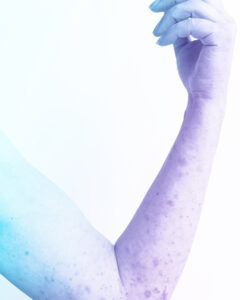What Does Cocaine Do to Your Skin: The Physical Changes Caused by Cocaine Use
In Florida, over 4,000 non-fatal overdoses were caused by stimulants such as cocaine in 2022. Do you know the signs of cocaine use in a loved one? Could you recognize the effects it has on the skin?
Clean Recovery Centers has been a leading provider of cocaine use disorder treatment and is able to address all facets of addiction. Our program focuses on wellness, including mediation, brain mapping, and Kinesio Taping® as a part of the healing process. Today, we are exploring what cocaine does to the skin and how you can help a loved one to begin healing.

Understanding Skin Health and the Impact of Cocaine
The skin is the largest organ in the human body and is tasked with protecting us from various toxins and infections. Taking care of the skin ensures that your body and well-being are protected, but substances like cocaine can affect how well the skin functions.
Cocaine is a powerful stimulant that has a high risk of developing dependence. It causes feelings of intense pleasure, increased productivity, and mood swings. The effects of this substance are short-lived, often leading to binge use. Because of this, a cocaine use disorder can progress before the person realizes it. Over time, the skin will show different negative effects.
 How Cocaine Can Affect Your Skin
How Cocaine Can Affect Your Skin
The skin can experience many different conditions and effects from cocaine. It can be swallowed, injected, snorted, and smoked. These methods can influence different conditions and impacts on the skin, but some occur no matter the method of use.
The Direct Impact on Skin From Cocaine
Cocaine causes the blood vessels and capillaries within the body to constrict, referred to as vasoconstriction. When this occurs, blood flow becomes restricted, forcing the heart to work harder to pump blood throughout the body. This can cause capillaries to burst, leading to purpura. Purpura is characterized by purple lesions on the skin which may resemble bruising. This is a result of internal bleeding and can occur anywhere on the skin but may be localized to the extremities.
While most often seen in those who use methamphetamines, cocaine can cause hallucinations similar to “bugs under the skin.” This is known as formication and can lead to increased itching or picking at the skin. Increased bleeding and opening of the skin can lead to scarring and possible infections.
Skin Infections Associated With Cocaine Use
Cocaine can be dissolved in water and injected. Anytime a needle punctures the skin, there is a wound left behind. Open wounds in the skin allow for infections and toxins to enter the body, weakening the area of skin protection. While needle punctures are relatively small, the exposed area becomes susceptible to developing abscesses and other infections. Environment plays a role in this – if the needle, water, syringe, or skin are contaminated in any way, the risk of complications increases. Abscesses are not always life-threatening, but they can turn to further infections and eventually sepsis. Sepsis is a condition where the body turns on itself while fighting infection, leading to organ failure.
The skin is a part of the immune system within the body. Cocaine reduces appetite, decreases sleep, and causes increased agitation between uses. The immune system needs these to function properly, and infections can become difficult to heal when it is impaired. Without proper nutrition and sleep, cocaine opens the door for small injection wounds or cuts to become more severe and harder to heal from.
The Long-Term Effects of Cocaine Use on Skin
In the long-term, cocaine can cause permanent effects on the skin. When injecting cocaine, there is a risk of developing HIV/AIDS or hepatitis C. HIV can cause skin rashes that resemble flat, red areas with small bumps. It can also make the person more susceptible to sunlight and chemical exposure. While hepatitis C mostly affects the liver, skin changes such as itching, bumps, and rashes can be an indicator of the condition.
Chronic Cocaine Use Skin Conditions
Cocaine can affect the skin in other chronic ways as well. This substance causes vasoconstriction, which directly impacts the blood vessels. Blood vessels can become blocked, which weakens their integrity. Vasculitides indicate the presence of inflammatory leukocytes within blood vessel walls. These are a surefire sign of damage and can lead to serious complications. If a blood blockage occurs in the brain, a stroke will most likely ensue.
The same risk can be said about the heart as a blockage can cause a heart attack. When it comes to the skin, blockages underneath can become prominent purple patches and even lead to a state of necrosis. Necrotic tissue can cause serious problems and require removal. While tissue can sometimes be grafted and replaced, not every area of the body has that option.
Aging and Skin Damage From Cocaine
Because cocaine typically brings on binge use patterns, the skin and body take a toll in the process. To keep the skin healthy, proper diet, sleep, and emotional regulation all contribute to how the skin looks and functions. Cocaine disrupts these processes, which can cause the skin to begin again prematurely. Poor nutrition can also cause the skin to stretch and sag in early and middle age, resulting in early aging. Even though cocaine may seem to make the person feel more alert and young, the damage underneath the skin can cause aging and skin damage.
Is Treating Skin Damage From Cocaine Use Possible?
While certain skin conditions can be treated, cocaine use can cause permanent issues and disfiguration. When snorted, the nasal cavities withstand the harsh chemicals and toxicity of cocaine. This can lead to cuts, inflammation, and irritation of the nasal wall. Over time, the nasal passageways can deteriorate. Necrosis and tissue death can arise within the nasal wall, and eventually, the whole cavity can collapse. While not necessarily life-threatening, this collapse can result in surgery and reconstruction of the nose. Without treatment, conditions such as a deviated septum and septum collapse can occur and cause breathing problems.
When it comes to skin concerns, vascular health is the number one issue with cocaine use. Regulating blood flow can help correct problems with bruising and build-up of fluid. Refraining from cocaine use is the best way to resolve skin issues. A medical doctor can help with infections and can also prescribe medications that work to restore blood flow while promoting health. However, some conditions such as purpura may need surgical intervention to remove damaged tissue. Severity will always play a role in the intervention of treating skin conditions caused by cocaine use.
Cocaine Addiction Treatment Is Here in Tampa, FL
Wondering why your skin is changing may be as simple as addressing cocaine use. The good news is that cocaine addiction treatment is available and can help you get started on the path to healing today. By entering a treatment program, you will be able to find the root causes of your addiction while focusing on your health and well-being. With daily therapies, coping skill development, and relearning your passions, you will be free to recover in solace away from cocaine and the triggers that led you to use it in the first place. There is no set path to recovery, but treatment will help you find what works for you and how you can use it to the best of your ability.
If you or someone you love is experiencing the negative side effects of cocaine on the skin, it’s not too late to reach out for help. Clean Recovery Centers understands how stimulants like cocaine can change the way the brain functions. Together, we come up with a plan that will suit each individual to allow for a completely successful recovery. Call us today at (888) 330-2532 to learn more about our program offerings.
Get clean. Live clean. Stay clean.


